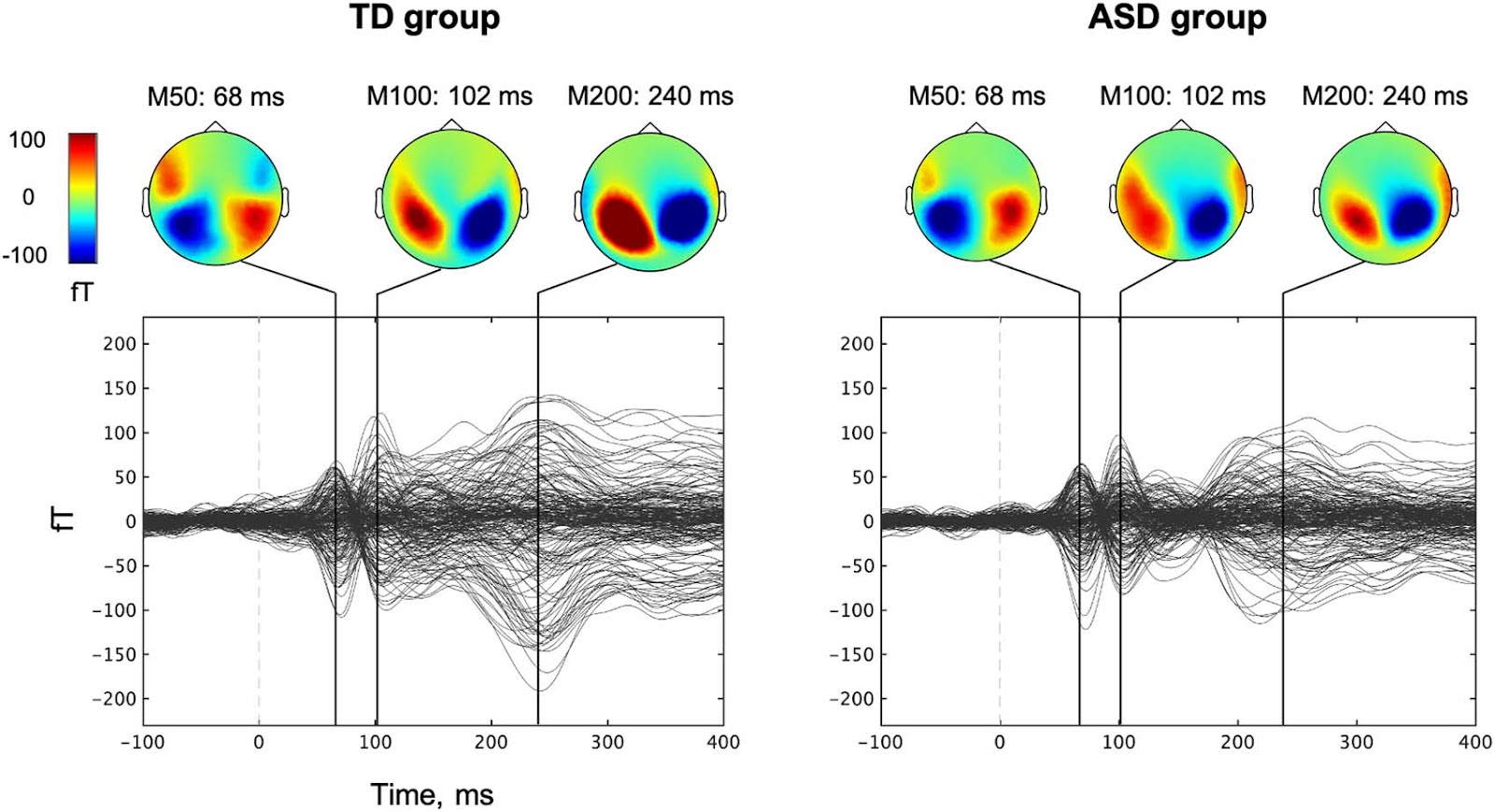Children with Autism Process Sounds Differently

For the first time, an international team of researchers—including scientists from the HSE Centre for Language and Brain—combined magnetoencephalography and morphometric analysis in a single experiment to study children with Autism Spectrum Disorder (ASD). The study found that children with autism have more difficulty filtering and processing sounds, particularly in the brain region typically responsible for language comprehension. The study has been published in Cerebral Cortex.
Autism, or Autism Spectrum Disorder (ASD), is a group of neurodevelopmental conditions that affect how a person perceives themselves, relates to others, and communicates. These conditions can vary widely, but people with ASD often have difficulty perceiving and processing sounds—for example, distinguishing speech in noisy environments, adapting to loud stimuli, or ignoring repetitive noises. Research indicates that these difficulties are linked to the functioning of the primary auditory cortex—the part of the brain’s temporal lobe responsible for basic sound processing. However, the precise ways in which auditory processing impacts language and communication in individuals with ASD remain poorly understood.
To explore the link between sound perception and language difficulties in children with ASD, researchers from the HSE Centre for Language and Brain, together with colleagues from Russia, the USA, and New Zealand, conducted a comprehensive study. They combined two methods: magnetoencephalography (MEG), which tracks brain activity in response to specific stimuli with millisecond precision, and morphometric analysis based on structural MRI data, which examines both the quantitative and qualitative features of the auditory cortex—such as its volume, thickness, and the shape of its gyri.
The study included 40 children—20 with typical development and 20 with a confirmed diagnosis of ASD. While the children listened to simple sounds—short clicks—scientists recorded their brain activity. The researchers focused on three components of the brain’s auditory response: M50, M100, and M200, which occur 50, 100, and 200 milliseconds after the sound is presented. Each of these components reflects a different stage of processing, ranging from basic perception to filtering and comprehension.
The most significant differences were found in the M200 component, which is involved in processing and filtering repetitive sounds. In children with ASD, this signal was significantly weaker, particularly in the left hemisphere, which is typically responsible for auditory perception and comprehension.

'We aimed to determine whether the perception of simple sounds is linked to language difficulties in children with ASD,' explains Olga Dragoy, Director of the HSE Centre for Language and Brain. 'Our results show that language difficulties in these children begin at a very early stage, when the brain first recognises and processes basic sounds.'
Anatomically, children with ASD exhibit two features: the auditory cortex in their left hemisphere is thinner, and the gyri are more curved and deeper. It was found that the more pronounced these differences, the greater difficulties children have with language comprehension and communication.
'The auditory cortex in the left, "linguistic" hemisphere helps children not only distinguish sounds but also learn to comprehend language and speak,' explains Alina Minnigulova, Research Fellow at the HSE Centre for Language and Brain. 'Perhaps it develops differently in children with ASD, which in turn affects their ability to comprehend language. Studying the relationship between auditory processing and language skills can aid in early diagnosis and the development of new educational and therapeutic approaches for children with ASD.'
The study was conducted with support from HSE University's Basic Research Programme within the framework of the Centres of Excellence project.
See also:
Internal Clock: How Heart Rate and Emotions Shape Our Perception of Time
Our perception of time depends on heart rate—this is the conclusion reached by neuroscientists at HSE University. In their experiment, volunteers watched short videos designed to evoke specific emotions and estimated each video's duration, while researchers recorded their heart activity using ECG. The study found that the slower a participant's heart rate, the shorter they perceived the video to be—especially when watching unpleasant content. The study has been published in Frontiers in Psychology.
Scientists Identify Personality Traits That Help Schoolchildren Succeed Academically
Economists from HSE University and the Southern Federal University have found that personality traits such as conscientiousness and open-mindedness help schoolchildren improve their academic performance. The study, conducted across seven countries, was the first large-scale international analysis of the impact of character traits on the academic achievement of 10 and 15-year-olds. The findings have been published in the International Journal of Educational Research.
HSE Researchers Determine Frequency of Genetic Mutations in People with Pulmonary Hypertension
For the first time in Russia, a team of scientists and clinicians has conducted a large-scale genetic study of patients with pulmonary arterial hypertension. The team, which included researchers from the International Laboratory of Bioinformatics at the HSE Faculty of Computer Science, analysed the genomes of over a hundred patients and found that approximately one in ten carried pathogenic mutations in the BMPR2 gene, which is responsible for vascular growth. Three of these mutations were described for the first time. The study has been published in Respiratory Research.
HSE Scientists Reveal How Disrupted Brain Connectivity Affects Cognitive and Social Behaviour in Children with Autism
An international team of scientists, including researchers from the HSE Centre for Language and Brain, has for the first time studied the connectivity between the brain's sensorimotor and cognitive control networks in children with autism. Using fMRI data, the researchers found that connections within the cognitive control network (responsible for attention and inhibitory control) are weakened, while connections between this network and the sensorimotor network (responsible for movement and sensory processing) are, by contrast, excessively strong. These features manifest as difficulties in social interaction and behavioural regulation in children. The study has been published in Brain Imaging and Behavior.
Similar Comprehension, Different Reading: How Native Language Affects Reading in English as a Second Language
Researchers from the MECO international project, including experts from the HSE Centre for Language and Brain, have developed a tool for analysing data on English text reading by native speakers of more than 19 languages. In a large-scale experiment involving over 1,200 people, researchers recorded participants’ eye movements as they silently read the same English texts and then assessed their level of comprehension. The results showed that even when comprehension levels were the same, the reading process—such as gaze fixations, rereading, and word skipping—varied depending on the reader's native language and their English proficiency. The study has been published in Studies in Second Language Acquisition.
Mortgage and Demography: HSE Scientists Reveal How Mortgage Debt Shapes Family Priorities
Having a mortgage increases the likelihood that a Russian family will plan to have a child within the next three years by 39 percentage points. This is the conclusion of a study by Prof. Elena Vakulenko and doctoral student Rufina Evgrafova from the HSE Faculty of Economic Sciences. The authors emphasise that this effect is most pronounced among women, people under 36, and those without children. The study findings have been published in Voprosy Ekonomiki.
Scientists Discover How Correlated Disorder Boosts Superconductivity
Superconductivity is a unique state of matter in which electric current flows without any energy loss. In materials with defects, it typically emerges at very low temperatures and develops in several stages. An international team of scientists, including physicists from HSE MIEM, has demonstrated that when defects within a material are arranged in a specific pattern rather than randomly, superconductivity can occur at a higher temperature and extend throughout the entire material. This discovery could help develop superconductors that operate without the need for extreme cooling. The study has been published in Physical Review B.
Scientists Develop New Method to Detect Motor Disorders Using 3D Objects
Researchers at HSE University have developed a new methodological approach to studying motor planning and execution. By using 3D-printed objects and an infrared tracking system, they demonstrated that the brain initiates the planning process even before movement begins. This approach may eventually aid in the assessment and treatment of patients with neurodegenerative diseases such as Parkinson’s. The paper has been published in Frontiers in Human Neuroscience.
'Biotech Is Booming Worldwide'
For more than five years, the International Laboratory of Bioinformatics at the HSE Faculty of Computer Science has been advancing cutting-edge research. During this time, its scientists have achieved major breakthroughs, including the development of CARDIOLIFE—a unique genetic test unmatched worldwide that predicts the likelihood of cardiovascular disease. With the active participation of HSE students, including doctoral students, the team is also working on a new generation of medicines. In this interview with the HSE News Service, Laboratory Head Maria Poptsova shares insights into their work.
Civic Identity Helps Russians Maintain Mental Health During Sanctions
Researchers at HSE University have found that identifying with one’s country can support psychological coping during difficult times, particularly when individuals reframe the situation or draw on spiritual and cultural values. Reframing in particular can help alleviate symptoms of depression. The study has been published in Journal of Community Psychology.




